I’m boarding a Porter flight bound for Montreal, where I’ll be attending CUSEC (Canadian University Software Engineering Conference). I’ll be there from today through Saturday afternoon, watching technical presentation, flying the Microsoft banner, hosting DemoCamp and having a beer (or twelve) with my fellow conference-goers. I’ll be posting notes and photos from the presentations and other goings-on, so watch this space!
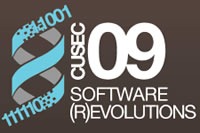 Microsoft was a sponsor of CUSEC last year – that’s Canadian University Software Engineering Conference, the premier conference on building software aimed specifically at students. One of the perks of sponsorship was a “corporate speaker” slot, and it was decided that the presentation should be given it to the then-new guy…namely, me.
Microsoft was a sponsor of CUSEC last year – that’s Canadian University Software Engineering Conference, the premier conference on building software aimed specifically at students. One of the perks of sponsorship was a “corporate speaker” slot, and it was decided that the presentation should be given it to the then-new guy…namely, me.
At the time I got slotted in as the speaker, I’d barely been a Microsoft employee for two months and was still feeling my way around both the company and its technology. By the time I would stand on the podium, I would have just passed my three-month probationary period. If I was going give a talk for forty-five minutes, it would have to be something other than “what it’s like to work at The Empire”.
Luckily, I did have something to talk about: a not-quite-normal career in tech, and the lessons I picked up along the way. The end result was a presentation titled Squeezeboxes, Start-Ups and Selling Out: A Tech Evangelist’s Story (yes, it’s a bombastic title, but it’s the sort of thing you’d expect from a guy whose personal blog’s name is The Adventures of Accordion Guy in the 21st Century.)
The presentation was scheduled for the end of Day 2 (it’s a three-day conference), which is a challenge. The audience would be tired and being students, they were likely to be more focused on the big drinkfest that would take place that evening. I decided to go for “offbeat” and built my presentation around the abstract I gave to them, which was:
You’ll spend anywhere from a third to half (or more) of your waking life at work, so why not enjoy it? That’s the philosophy of Microsoft Developer Evangelist Joey deVilla, who’s had fun while paying the rent. He’ll talk about his career path, which includes coding in cafes, getting hired through your blog, learning Python at Burning Man, messy office romances, go-go dancing, leading an office coup against his manager, interviewing at a porn company and using his accordion to make a Microsoft Vice President run away in fear. There will be stories, career advice and yes, a rock and roll accordion number or two.
They recorded my session and unleashed it on the world yesterday. I share it with you below:
If you watched the video, you’ll note that I skipped a couple of stories, namely “learning Python at Burning Man”, “messy office romances”, “go-go dancing” and making a Microsoft Vice President run away in fear. I’ll save those for another presentation. (By the bye, the guy I made run away is a President now.)
I had a blast doing this presentation, and the general consensus of the attendees was that it was one of the highlights of the conference. I’m honoured that I was invited back to host DemoCamp, and look forward to chatting with everyone. See you in Montreal!
This article also appears in Canadian Developer Connection.
Netbook Experiment Report #1
 In case you hadn’t read my article from Friday, I’m conducting a little experiment this week – I’m seeing what it’s like to use a “netbook“ computer (a Dell Latitude 2100, to be specific) as my primary machine for the whole week. I’m trying this out as a response to Jeff “Coding Horror” Atwood’s article, in which he rebuts my argument that the computers we typically classify as “netbooks”, occupy a neither-here-nor-there, worst-of-both-worlds middle ground between smartphones and laptop computers.
In case you hadn’t read my article from Friday, I’m conducting a little experiment this week – I’m seeing what it’s like to use a “netbook“ computer (a Dell Latitude 2100, to be specific) as my primary machine for the whole week. I’m trying this out as a response to Jeff “Coding Horror” Atwood’s article, in which he rebuts my argument that the computers we typically classify as “netbooks”, occupy a neither-here-nor-there, worst-of-both-worlds middle ground between smartphones and laptop computers.
As I promised in that earlier article, I’d report on my experiences. This is the first of a number of such reports that I plan to file throughout the week.
Jeff Atwood Replies
Jeff saw my article and replied in Global Nerdy, warning me that I’d be disappointed with my particular netbook’s performance due to its Intel Atom processor:
I can guarantee you’ll be unhappy with the Atom CPU. It’s OK for light web browsing, but that’s it. That’s all. No mas.
I was disappointed, but not surprised, that Intel shows zero interest in making the next-gen Atom faster. Pineview is much better power wise but nil improvement in performance.
The good news is that the CULV Pentiums — like the dual core model in the Acer Aspire 4100 I wrote about — are about 2x faster than the Atom and surprisingly power efficient. Totally acceptable for medium duty laptop stuff.
The key to being satisfied with a netbook is to get out of the Intel Atom ghetto that Intel wants to keep them in…
Visual Studio Express 2010: Too Slow
![]() As a Developer Evangelist for Microsoft, one of the tools I use most often is Visual Studio, the integrated development environment that’s typically used for developing applications for Microsoft-based platforms, from the desktop to web applications hosted on Windows Server, to mobile apps for Windows Phone and Zune to console apps for the Xbox 360. I currently run both Visual Studio 2008 and Beta 2 of Visual Studio 2010.
As a Developer Evangelist for Microsoft, one of the tools I use most often is Visual Studio, the integrated development environment that’s typically used for developing applications for Microsoft-based platforms, from the desktop to web applications hosted on Windows Server, to mobile apps for Windows Phone and Zune to console apps for the Xbox 360. I currently run both Visual Studio 2008 and Beta 2 of Visual Studio 2010.
Visual Studio 2010 (along with the free Express versions) is the first version of Visual Studio to be built using WPF – Windows Presentation Foundation – the relatively new graphics framework for Windows desktop applications, which makes it easier to give apps the sort of modern appearance that users have come to expect these days. Visual C# Express 2010 and Visual Web Developer 2010 are based on the full version of Visual Studio 2010, and the combination of WPF and the fact that they’re beta 2 and not yet fully optimized proved to be too much for the netbook. I spent a lot of time waiting as they loaded, created new projects, switched views and built apps – more time than I thought was reasonable. I’ve since uninstalled them.
Visual Studio Express 2008: Works Just Fine
![]() On the other hand, Visual C# Express 2008 and Visual Web Developer 2008 work just fine. I’m having no trouble building apps in ASP.NET MVC, Silverlight or XNA and experiencing no slow-downs. It remains to be seen if the final versions of Visual Studio 2010 with their final optimizations will run without the slowdowns.
On the other hand, Visual C# Express 2008 and Visual Web Developer 2008 work just fine. I’m having no trouble building apps in ASP.NET MVC, Silverlight or XNA and experiencing no slow-downs. It remains to be seen if the final versions of Visual Studio 2010 with their final optimizations will run without the slowdowns.
I’ll post more updates as I have more experiences!
The “Mythbusters” Poster
I love this “Drew”-style poster featuring the cast of Mythbusters:
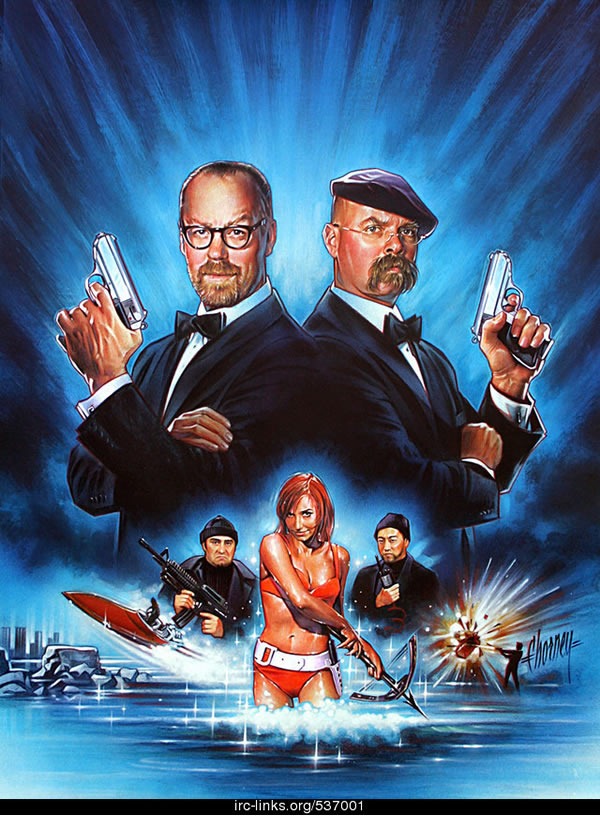
If you’ve been to the movies sometime within the past 30 years, you’ve probably seen a poster by Drew. You can see a catalogue of his posters that were released here; there’s also a page of his “posters that never were”.
This article also appears in The Adventures of Accordion Guy in the 21st Century.
For the latter half of this week, I’ll be at CUSEC – the Canadian University Software Engineering Conference – the annual Montreal-based conference by and for Canadian university students interested in topics on software development and engineering. For a conference that’s aimed at students, it punches above its weight class, having hosted some big name speakers including:
- Richard M. Stallman (last year, in a presentation where I won the auction for a Free Software Foundation plush gnu and offered to pay for it with my Microsoft corporate credit card)
- David Parnas
- Kathy Sierra
- Ralph Johnson
- Kent Beck
- Alistair Cockburn
- Dave Thomas
- Tim Bray
- Zed Shaw
- Jeff Atwood
This year’s speaker list is pretty good. Among them are:
- Douglas Crockford, Senior JavaScript Architect at Yahoo!. If you truly want to understand JavaScript, listen to this guy! When people were dismissing JavaScript as a toy language – a strange concept in these Ajax-powered days, but this really was the case – he wrote articles like JavaScript: The Wrrrld’s Most Misunderstood Programming Language and other must-read pieces, all of which live at javascript.crockford.com. He’s also the author of the book JavaScript: The Good Parts, which is required reading for web developers. I had the pleasure of meeting him and seeing him speak at the Ajax Experience conference in Boston in 2006, and he’s both a great presenter and guy to hang out with at apres-conference events.
- Greg Wilson, Assistant Professor at U of T. Greg is many things: much-sought-after provider to academic advice and support at U of T, co-editor of Beautiful Code, DemoCamp Toronto steward, and now, the guy behind the best presentation at the Stack Overflow DevDays Toronto: Bits of Evidence: What We Actually Know About Software and Why We Believe It’s True. It was the presentation so nice, he’s doing it twice – this time at CUSEC. Don’t miss this one!
- Reg Braithwaite, Superprogrammer-at-large. Whether you know him as “Reg” or “raganwald”, you know that he’s got some seriously big-ass ideas about programming. Very few people push Ruby metaprogramming to its limits the way he does. Every time I see one of his presentations, I come out a little bit smarter.
- Pete Forde, Unspace. Pete’s one of the “corporate speakers”, a designation that probably makes him feel very uncomfortable. He’s one of the guys behind the Toronto-based development shop Unspace and behind two of the best conferences I’ve ever attended, RubyFringe (2008) and FutureRuby (2009). It’s anyone’s guess as to what he’ll talk about, but it should be good, and we can only hope that he begins it with a dance number, like he did with his presentation at the Mesh 2009 conference.
- Leigh Honeywell, Symantec. Leigh has forgotten more about security than I will ever learn, and she’s also one of the founders of HacklabTO, the Toronto “hackerspace”.
I had the opportunity to speak at last year’s CUSEC and had a wonderful time both speaking and hanging out with the students. I love the conference vibe – the energy, brainpower and passion of the attendees is palpable, and it makes me optimistic for the future of tech in Canada. I’m only too glad to be able to attend this year, and I’m honoured to be invited to host their DemoCamp event, which will take place Thursday evening.
I’ll be filing reports from CUSEC, so watch this space!
 In case you hadn’t heard the news last week, the newest version of the jQuery JavaScript library, version 1.4, has been released! Even with the new features, it’s still tiny: the uncompressed development version is 156KB and the minified production version is a svelte 23KB when gzipped.
In case you hadn’t heard the news last week, the newest version of the jQuery JavaScript library, version 1.4, has been released! Even with the new features, it’s still tiny: the uncompressed development version is 156KB and the minified production version is a svelte 23KB when gzipped.
To celebrate this release, the jQuery folks have created a site called The 14 Days of jQuery, where they’ll post all sorts of supporting articles on the jQuery 1.4 for 14 days, starting on the day that was both the release date of jQuery and its birthday, January 14th. So far, they’ve posted the expected download links to jQuery 1.4 as well as a Q&A session with some of the jQuery team, a jQuery podcast with John Resig, a contest for the coolest use of jQuery, a presentation of how to get involved in the jQuery community and more.
Multitasking in the “Mad Men” Era
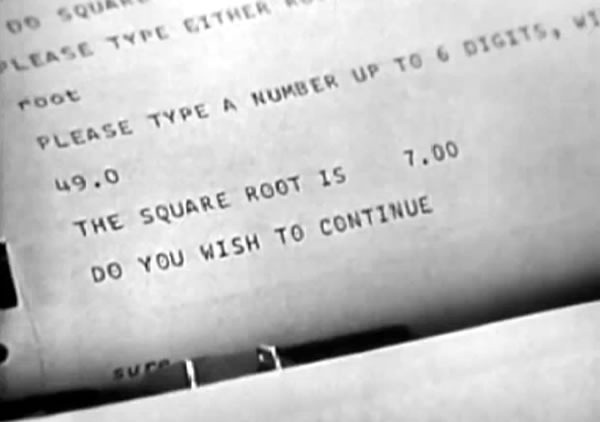
Here’s a great video from 1963 featuring the great-granddad of today’s web servers and cloud computing systems. It was just posted by Boston’s Computer History Museum titled Solution to Computer Bottlenecks. Filmed in May of that year, it features MIT Science Reporter John Fitch – who has a classic 1960’s announcer’s voice – interviewing MIT computer scientist Fernando J. Corbato, the guy behind Corbato’s Law (“The number of lines of code a programmer can write in a fixed period of time is the same independent of the language used”).
The subject of the film is the then-new approach of timesharing, which Corbato describes as “connecting a large number of consoles to a central computer”, which made the great (and very necessary – it even gets mentioned in Malcolm Gladwell’s book, Outliers) leap from batch to interactive processing possible. Here’s the video; enjoy all the retro-tech goodness:
This may have been really deep nerd stuff back in 1963, but today, it the sort of thing that you might see covered in a grade school class. Even if you’re not a programmer or IT pro, I think you’ll find it entertaining.
Some Gems from the Video
A computer terminal in one’s office isn’t unusual in this day and age, but back in 1963, such a thing must’ve been incredibly super-1337. Here’s the console in Corbato’s office, which he introduces by saying “Here’s one of the consoles we might be using in the future.” Even to the reporter of that era, it looked like an ordinary IBM Selectric typewriter:

The general principles of digital computers haven’t changed much since those days. Corbato describes memory as “a bunch of pigeonholes” that store numbers, some of which function as data, some of which function as instructions.
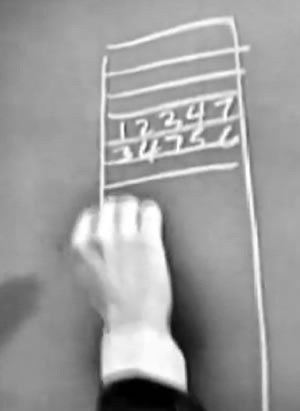
The concept of a CPU, the program counter stepping through memory and looping already existed in 1963:
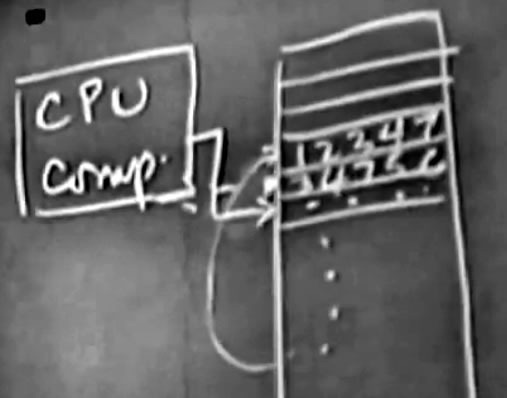
He describes the new setup “a set parallel consoles which are not all near the computer in fact, most of them are remote…and let the users use these with a reaction time of a few seconds instead of a few hours.”
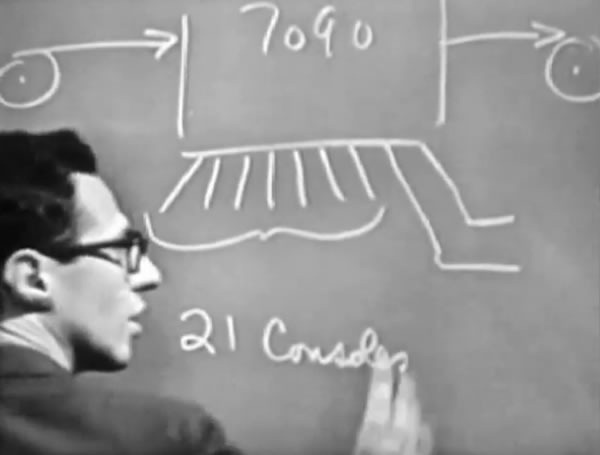
He says that eventually they’d like to switch from “typewriter” consoles to "graphic displays”, but at the time there were still some kinks to be worked out.
One of the “elaborate advanced ideas” that he hints at but says is beyond the topic of the film is going beyond hooking up dumb terminals to the mainframe and attaching smaller computers to it as well, such as the DEC PDP-1 and 1620:
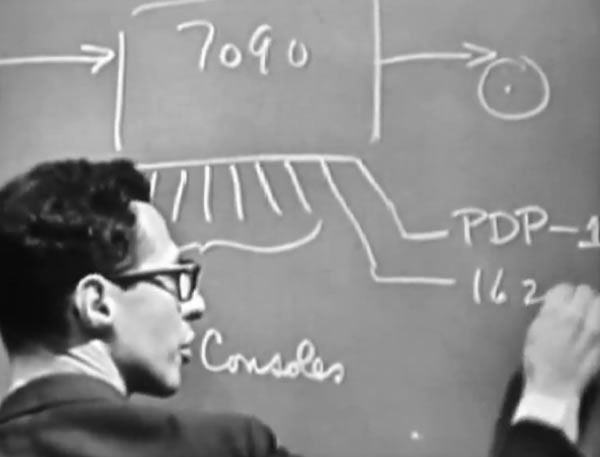
When discussing the hard disk and its capacity (9 million words), Corbato has to explain to Fitch that it isn’t a big whirling disk on which you store tape, but a platter coated with a magnetic material like tape. This is old hat to us in the 21st century, but at the time, disks weren’t household items:
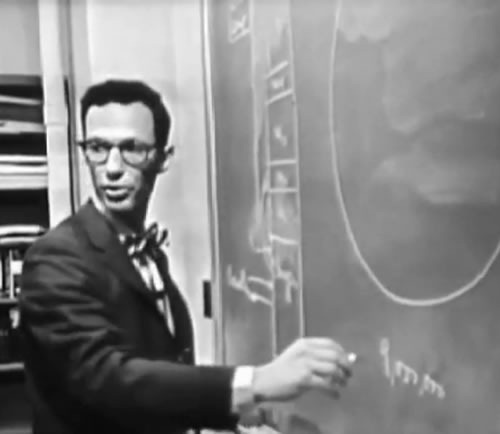
At the time, disks had been around for about a year. Corbato confesses that there are still some problems with them: they “haven’t figured out how to keep things from getting mixed up”.
And on it goes with ideas that are still in use today: programming languages (“a particular synthetic language which is largely technical, and which is to some extent algebra too”), the organization of different programs in memory at the same time, multitasking with a scheduler that determines which program gets the processor’s attention at the moment, file loading and management by the operating system, the concepts of “brute-force solutions”, context switching (which they can “keep down to 10%”), input validation and even the phrase “it’s a feature”.
The line of Corbato’s that I love most is his prescient statement about usability and demand: “We’ve really made the computer extremely easy to use here. And so it’s very clear that in the long run, we’re going to increase in the need for computer time by a large amount.”
This video is all sorts of old-school awesome. If you’ve got nothing to do on your lunch break, check it out!
This article also appears in The Adventures of Accordion Guy in the 21st Century.

